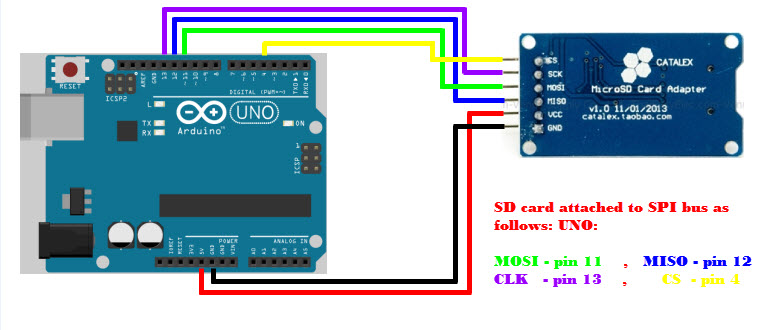
- #Arduino nano pinout sd card how to
- #Arduino nano pinout sd card pdf
- #Arduino nano pinout sd card software
- #Arduino nano pinout sd card code
Most SD card modules are based on SPI mode (less overhead & lower speed). How do you interface a standard SD card with Arduino? We have two methods for this: SDIO mode and SPI mode. So, you can refer to the process as “logic level shifting,” meaning the board can link with two microcontrollers like Arduino: 3.3V and 5V. In addition, the SD card has a chip on the module (74LVC125A), which helps to change the connecting logic from 3.3 – 5V to 3.3V. Hence, that’s why a module features a regulator (onboard ultra-low dropout) that changes current voltage from 3.3 – 6V to approximately 3.3V. In short, if you attempt working with voltages above 3.6V, it will destroy your SD card. Further, the working voltage of most micro SD cards is 3.3V.Īs a result, it’s impossible to connect the device directly to 5V logic circuits. And these components help you include data logging to your Arduino project easily.

#Arduino nano pinout sd card pdf
The Arduino Nano Every is open-source hardware! You can build your own board using the following files:ĭownload the full pinout diagram as PDF here. The Arduino Nano Every is based on the ATMega4809 microcontroller. You can find here your board warranty information. Need any help with your Nano Every board please get in touch with the official Arduino User Support as explained in the Arduino Contact Us page.
#Arduino nano pinout sd card how to
Need Help?Ĭheck the Arduino Forum for questions about the Arduino Language, or how to make your own Projects with Arduino.
#Arduino nano pinout sd card software
The Getting Started section contains all the information you need to configure your board, use the Arduino Software (IDE), and start tinkering with coding and electronics. To know more about the history of the Nano Every don’t miss the interview with Dario Pennisi, Arduino’s hardware and firmware development manager, who led the development of this board. These features allow you to solder the board directly onto your own design, minimizing the height of your whole prototype. The board comes with tessellated connectors and no components on the B-side. The main differences are: a better processor, and a micro-USB connector.
#Arduino nano pinout sd card code
Your code will still work, and you will NOT need to re-wire those motors you planned in your original design. If you used Arduino Nano in your projects in the past, the Nano Every is a pin-equivalent substitute. This will allow you to make larger programs than with the Arduino Uno (it has 50% more program memory), and with a lot more variables (the RAM is 200% bigger). The Arduino Nano Every is an evolution of the traditional Arduino Nano board, but features a lot more powerful processor, the ATMega4809. The small footprint and low price, make the Nano Every particularly suited for wearable inventions, low cost robotics, electronic musical instruments, and general use to control smaller parts of a larger projects.


The Arduino Nano is the preferred board for many projects requiring a small and easy to use microcontroller board.

The Nano Every is Arduino’s 5V compatible board in the smallest available form factor: 45x18mm!


 0 kommentar(er)
0 kommentar(er)
